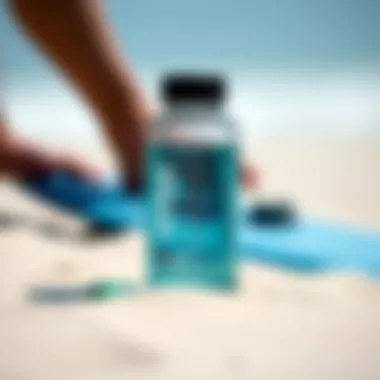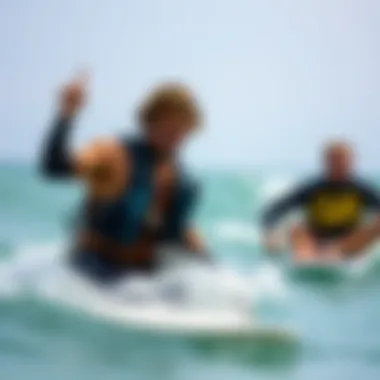Recognizing Dehydration: Signs and Effects for Surfers


Intro
Surfing is not just a sport; it's a lifestyle and a constant dance with the elements. But as any seasoned surfer knows, staying hydrated while riding those waves is crucial. Dehydration can creep up unexpectedly, especially when engaged in high-energy activities. Recognizing the signs, understanding the implications, and adopting practical hydration strategies can make all the difference between a thrilling surf session and a potentially dangerous one.
In this guide, we’ll explore the subtle indicators of dehydration and how they can impact performance. We’ll also dive into practical assessment methods to help surfers stay on top of their game, ensuring that every wave ridden is both enjoyable and safe. The following sections lay out critical signs to look out for, tips for hydration, and behaviors to adopt before hitting the surf.
Surf Gear and Equipment
When it comes to surfing, having the right gear can enhance not just your performance but also your comfort level when in the water, particularly on hot days when dehydration is a real concern.
Latest Surfboard Technologies
Modern surfboards are a blend of creativity and advanced materials. Boards that are lighter yet more durable, like those made from epoxy or carbon fiber, can significantly improve your ride. When you're out in the sun for long periods, lightweight boards can reduce the effort needed to paddle, letting you save energy for those critical moments.
Additionally, some surfboards now feature built-in technology that can help monitor conditions, providing you with data that could alert you when it’s time to take a break for hydration. Investing in high-quality equipment tailored to your needs can result in better performance and health.
Essential Accessories for Surfers
It’s not just about the board. Several accessories can make your surf sessions safer and more enjoyable:
- Rash Guards: Protects your skin from chafing and the sun, reducing the risk of heat-related issues.
- Hydration Packs: Accessible and easy to use, allowing you to sip water without leaving the break.
- Sunscreen: Essential for preventing sunburns, which can worsen dehydration.
- Board Leash: Keeps your board from wandering away too far, allowing you to focus on hydrating.
While it might be tempting to only think about performance when choosing gear, consider how each piece affects your overall hydration and comfort.
Recognizing Signs of Dehydration
To maintain peak performance, surfers must be vigilant about the signs of dehydration. These can manifest in various ways:
- Thirst: An obvious red flag, don’t wait until you are parched.
- Dry Mouth: If your tongue feels like sandpaper, it’s time to hydrate.
- Fatigue: Lower energy levels can indicate insufficient fluid intake.
- Dizziness: If you're feeling lightheaded, it may be due to dehydration affecting blood pressure and circulation.
"Staying hydrated ensures that every wave feels like an extension of yourself, rather than a battle for breath."
Tips for Staying Hydrated
- Plan Ahead: Before heading out for a surf session, drink enough water to fill your reserve tank.
- Pace Yourself: Take breaks if needed, especially under the sun. Find some shade, have a drink, and then get back to riding.
- Flavor Your Water: Sometimes plain water can be boring. Adding a dash of lemon or consuming electrolyte drinks can make it more enticing.
- Monitor Body Weight: Weigh yourself before and after surfing. A drop in weight can indicate fluid loss, and you should replenish accordingly.
By incorporating these tactics into your routine, you'll keep dehydration at bay, safeguarding your health and allowing you to savor every moment catching those waves.
The End
Recognizing dehydration is vital for any surfer serious about their sport. By paying attention to your body, choosing the right gear, and implementing effective hydration strategies, you set the stage for an enjoyable and safe surfing experience. The ocean waits for no one, and neither should your hydration.
Understanding Dehydration
Dehydration is an often overlooked but critical aspect of our physical health, especially for those engaged in strenuous activities like surfing. When in the water, surfers exert a high level of energy which increases their need for hydration. Understanding this concept not only safeguards performance but also prevents dangerous health implications. It’s vital to grasp the essence of dehydration to care for oneself effectively and sustainably.
Let’s break down the importance of recognizing dehydration in a comprehensive manner. First, hydration influences nearly every function in our bodies. From regulating body temperature to maintaining energy levels, water plays a fundamental role. Surfers who fail to recognize their body’s signals might find themselves feeling fatigued and devoid of energy, impeding their ability to enjoy their time in the water.
Additionally, awareness of dehydration can improve athletic performance. When surf enthusiasts properly manage their fluid intake, they’re likely to experience enhanced endurance and concentration while riding waves. For surfers, even minor levels of dehydration can mean the difference between conquering a massive swell or being grounded on the shore.
Furthermore, understanding dehydration aids in preventing health risks. Severe dehydration can lead to complications, both immediate such as dizziness or fainting, and long-term like kidney dysfunction. By paying close attention to their hydration needs, surfers can stay safe while indulging in their passion. Lastly, knowledge empowers individuals to make informed decisions about fluid intake, ensuring that they are not just surfing the waves but doing so in a healthy manner.
By taking the time to understand dehydration, surfers and other active individuals can cultivate a balanced relationship with hydration. This knowledge brings forth a slew of benefits, improving performance and promoting overall health.
Physiological Signs of Dehydration


Recognizing the physiological signs of dehydration is pivotal not simply for athletes like surfers, but for anyone engaging in activities that require physical endurance or focus. Dehydration isn't just a minor inconvenience; it can impair performance, affect mental sharpness, and, in severe cases, lead to serious health issues. Understanding these physiological signals can serve as a first line of defense, alerting individuals to adapt their hydration strategies before complications arise.
Thirst as an Indicator
Thirst is often the first signal that the body sends out, alerting us to a need for hydration. It may seem naive to rely solely on this sensation, especially since we often overlook it until it becomes pronounced. But the fact is, if you're feeling thirsty, your body is already in a mild state of dehydration.
This warning system serves not just as a nudge to drink, but also as a biofeedback mechanism. When we're under the sun, riding waves, or even lounging by the beach, it’s easy to sidestep this cue. Carrying a water bottle can help remind individuals that staying hydrated is as essential as catching the perfect wave. Listening to this indicator can be a game changer for maximizing physical performance and ensuring overall well-being.
Changes in Urine Color
The color of urine is a direct reflection of the body's hydration status. Generally speaking, pale yellow urine suggests proper hydration, while darker shades may indicate the need for more fluids. This isn't just a vague guideline; using urine color as a hydration gauge is as effective as it is easy.
For surfers and athletes, monitoring urine can be straightforward. Carrying a small color chart can make it easier to evaluate hydration at a glance. Regular bathroom breaks can provide both a functional moment and an opportunity to check in on hydration levels. It’s a practical strategy: the lighter the urine, the better the hydration. Awareness of this sign can help avoid getting caught off guard by fatigue or cramping—problems that can muddle even the most experienced surfers’ performance.
Impact on Skin Elasticity
The skin's elasticity is another noteworthy physiological sign of dehydration. A quick test is to pinch the skin on the back of the hand; if it takes time to return to normal shape, it may be a signal to up hydration. Skin elasticity is crucial not only for aesthetic appeal but also for maintaining overall body homeostasis.
In the sun and saltwater, skin tends to lose moisture quickly. Therefore, while physical appearance matters, the implications of poor skin elasticity can reach far deeper. Healthy, hydrated skin contributes to better thermoregulation and overall bodily functions. For surfers who spend long hours in the ocean, maintaining skin elasticity and hydration can keep them feeling and looking their best.
It's crucial to recognize that dehydration can sneak up on even the most cautious surfer. Keeping an eye on these physiological indicators can help maintain optimal performance and safeguard overall health.
Behavioral Cues Related to Hydration
Understanding hydration is critical, especially for surfers and anyone engaging in physical activities. Recognizing the signs of dehydration goes beyond just the thirst signal. Attention to behavioral cues can provide a clearer perspective on one’s hydration status. By tuning into these cues, individuals can proactively manage their hydration levels, ensuring they perform at their best and safeguard their health.
Monitoring Energy Levels
Energy levels can tell a tale about one’s hydration status. If you’re out on the water and suddenly feel like your energy has plummeted, that’s a red flag. When your body lacks adequate fluid, it can’t produce the energy needed for optimal performance. This is particularly crucial for surfers who rely on endurance.
Feeling exhausted overly early during a surf session might not just be about physical exertion. It could be a sign your body is crying out for some water or electrolytes. Still, it's not always easy to pinpoint dehydration just from energy levels alone, so it's wise to check for other indicators. The body subtly communicates its needs, often manifesting in feelings of lethargy and weakness. Recognizing this early can help you take immediate action to hydrate.
Cognitive Function and Concentration
Hydration affects more than just physical exertion; it also plays a significant role in cognitive performance. When you find it hard to concentrate or make decisions in the lineup, it could be a hydration issue. A well-hydrated brain operates optimally, allowing for quick, sharp responses which are vital when surfing — whether waiting for the right wave or aligning your body for that perfect ride.
Inadequate fluid intake can lead to cognitive fog, clouded thinking, and a drop in reaction time. This is especially important to realize for surfers who must stay aware of their surroundings. If your thought process starts to feel sluggish, it’s time to refocus on your hydration strategy. It can be as simple as having a bottle nearby, encouraging yourself to drink throughout the day, not just when you’re feeling parched.
Signs of Fatigue and Dizziness
Fatigue and dizziness can come knocking quietly, sometimes catching surfers off guard when the ocean waves are calling. If you suddenly feel unsteady or lightheaded while catching a wave, it’s crucial to recognize this as a potential dehydration symptom. When the body is deprived of sufficient water, blood volume decreases, leading to reduced oxygen and nutrients reaching the muscles and brain. This can result in a mix of fatigue and dizziness that can seriously impact performance and safety.
The key here is to listen to your body. If you feel more tired than usual or find yourself wobbling a bit on your board, it’s not just a bad day; it could very well be a signal for rehydration. Consider keeping hydrating options handy, such as coconut water or electrolyte drinks, which can help mitigate these symptoms and keep you balanced in and out of the water.
"Hydration is not just about avoiding thirst; it's about maintaining performance and focus to ride the waves safely."
Recognizing these behavioral cues not only keeps the surfing experience enjoyable but can also prevent serious risks associated with dehydration. As awareness increases around how hydration affects energy, cognition, and overall well-being, surfers of all levels can enhance their performance and enjoyment on the water.
Environmental Influences
Understanding how various environmental factors shape hydration needs is crucial for anyone engaged in physical activities such as surfing. The conditions one faces, be it the scorching sun at the beach or the impact of altitude while taking in scenic views, can drastically influence how much water our bodies require. Recognizing these influences can make the difference between a stellar day on the water and a dehydrating one.
Effects of Climate on Hydration
Climate plays a pivotal role in hydration requirements. Hot, dry weather can swiftly drain moisture from the skin and deplete bodily fluids. Conversely, moderate temperatures may allow for sustained hydration without as much effort. Here are some specific considerations for surfers:
- Heat Exposure: In high temperatures, the body loses water through sweat to cool itself down. Surfers often feel invigorated by the waves but may overlook how much they've lost in perspiration.
- Humidity Levels: Interestingly, humid conditions can trick individuals into thinking they do not need to drink as much water. However, in these scenarios, hydration is still crucial since sweat does not evaporate easily. Little do they realize that even under these sweaty conditions, their body needs water to replace lost fluids.
- Sun Exposure: Prolonged sun exposure not only exacerbates heat-induced dehydration but also can lead to sunburn, which might increase fluid loss. So, don’t just slather on sunscreen; drink up!


In summation, counteracting climate impacts with regular water intake is essential, especially during long surf sessions.
Hydration Needs During Surfing
Surfing is an exhilarating activity that involves a considerable expenditure of energy and water. The physical demands are high, and thus, surfers need to be particularly mindful of their hydration levels. Here are a few strategies to keep hydrated while riding the waves:
- Pre-Surf Hydration: Before gearing up, it's vital to drink water. Aim for about 500 ml at least an hour before hitting the water.
- Fluid Intake During Surfing: While resting on your board or during breaks, take gulps of water. Doing so helps replenish the lost fluids. The salty ocean water might taste good, but it won’t do much in terms of hydration.
- Post-Surf Rehydration: After a day in the water, it’s smart to continue the hydration process. Consider including electrolytes to recover faster. This can be particularly useful after intense sessions.
Maintaining hydration needs in the surf isn’t just an afterthought; it’s a strategic approach to enhancing performance, strength, and safety.
Importance of Hydration in High Altitudes
High altitudes can pose unique challenges to hydration, one that many surfers might overlook when traveling to coastal mountain areas or engaging in surf retreats on elevated terrains. The air is typically thinner and drier, leading to increased fluid loss than at sea level. Here’s why staying hydrated in these conditions matters:
- Increased Respiratory Loss: At higher elevations, each breath taken results in more moisture being lost. This means hydration goes beyond just drinking water often, as you need to accommodate for that elevated moisture loss.
- Altitude Sickness: Dehydration can amplify symptoms of altitude sickness, causing headaches and feelings of nausea, both of which can turn a surfing adventure into a challenging experience.
- Optimal Performance: Hydration affects physical performance. Surfers operating at high altitudes must ponder their fluid needs more seriously in order to perform their best. Water can enhance stamina, endurance, and overall function on the waves.
Surfers must recognize these environmental influences to ensure that they not only enjoy their time on the water but also maintain the necessary balance of hydration to support their engaging lifestyles.
Hydration Strategies for Surfers
Staying hydrated while catching waves isn't just a suggestion; it's a fundamental aspect of a surfer's performance and well-being. Hydration Strategies for Surfers are crucial because, without them, the joy of surfing can turn into a struggle against fatigue or worse. Dehydration can sneak up on you, especially after long hours under the sun. Whether you're riding summer swells or winter barrels, understanding how to effectively manage your water intake is vital.
Effective Fluid Intake
Fluid intake is the backbone of hydration. As surfers, it's easy to underestimate how much water our bodies need, especially when absorbed in the thrill of the ocean. Here are some key takeaways for ensuring proper fluid intake:
- Prioritize water: Water should be your go-to drink. It’s the most accessible and effective way to keep yourself hydrated. Avoid sugary drinks, as they can lead to further dehydration.
- Monitor your surroundings: In hotter climates, you need more fluid. Surfing under the blazing sun can sap your body’s water reserves quickly.
- Consider your body weight: A common guideline is to aim for half your body weight in ounces per day. For example, if you weigh 160 lbs, try to drink about 80 ounces of water daily, adjusting upwards for activity level.
"A well-timed sip can be the difference between a great surf session and an exhausting one."
Timing and Quantity for Optimal Hydration
Timing is just as important as how much you drink. Hydration is not something you can leave to the last minute before hitting the water. Here are some tips on when and how much to drink:
- Hydrate before, during, and after: Start hydrating at least a few hours before you plan to surf. This pre-emptive approach allows your body to absorb the fluids effectively. During surfing, take small sips every 20 minutes or so. After your session, replenish thoroughly to aid recovery.
- Symptom awareness: If you're feeling thirsty, it's already a sign you might be on the verge of dehydration. Beat the dry mouth with proactive hydration. Don’t wait until you feel parched to grab your water bottle.
Utilizing Electrolytes and Sports Drinks
While water is essential, sometimes it just doesn’t cut it, especially after a long and exhausting surf session. That’s where electrolytes and sports drinks come into play:
- Why electrolytes matter: When you sweat, you lose not just water but also vital electrolytes like sodium, potassium, and magnesium. If you're sweating buckets, you may need to replace these to maintain balance.
- Choosing wisely: Not all sports drinks are created equal. Look for options with low sugar and high electrolyte content. Brands like Gatorade and Nuun are popular for their effective hydration properties.
- Natural alternatives: Coconut water is an excellent natural source of electrolytes. Plus, it’s lower in sugar than many commercial sports drinks.
Recognizing Severe Dehydration
Understanding when dehydration becomes severe is crucial for anyone engaged in activities that can quickly drain their body of fluids, such as surfing. Recognizing severe dehydration can be the difference between recovery and a serious health crisis. Surfing demands physical stamina and mental clarity, both of which can be compromised when hydration levels drop significantly. Surfers, athletes, and outdoor enthusiasts must stay informed about the signs of acute dehydration. Noting these indicators can enhance not only performance but also safety during high-energy activities.
Symptoms of Advanced Dehydration
When dehydration escalates to a severe level, the body's response becomes more pronounced. Here are the most critical symptoms to be aware of:
- Extreme Thirst: This isn’t just a casual desire for water; it's a strong and relentless urge that can't be ignored.
- Very Dark Urine: A distinct dark yellow or amber color signals significant dehydration.
- Significantly Reduced Urination: Less frequent trips to the bathroom may indicate that the body is conserving water.
- Dry Skin and Mucous Membranes: Skin may appear noticeably dry, and mucous membranes, such as in the mouth and nose, might feel parched.
- Rapid Heart Rate: An elevated heart rate is the body's way of compensating for reduced blood volume.
- Confusion or Dizziness: Cognitive functions can be impaired, leading to confusion or lightheaded sensations.
It’s imperative to recognize these signs early on. Severe dehydration can progress rapidly and requires immediate action to prevent more serious health issues.
Potential Health Risks
The implications of untreated severe dehydration can vary widely, from mild discomfort to life-threatening situations. Some potential health risks include:


- Kidney Damage: Prolonged dehydration can lead to kidney stones or even kidney failure due to the kidneys not receiving enough fluid to function properly.
- Heat-Related Illnesses: Without adequate hydration, the risk of heat exhaustion or heat stroke increases significantly, especially when in direct sunlight.
- Electrolyte Imbalance: A lack of fluids can throw off the body’s electrolyte balance, leading to issues such as muscle cramps or seizures.
- Hypovolemic Shock: Dehydration causes a decrease in blood volume. This can lead to hypovolemic shock, which is a critical medical emergency.
- Mortality: In extreme cases, severe dehydration can become fatal if not treated in time.
Understanding these risks can motivate individuals to prioritize hydration before, during, and after physical activity, especially in rigorous environments like surfing.
When to Seek Medical Attention
Identifying the moment to reach out for medical help can be life-saving. If you or someone else exhibits these signs, it’s time to act:
- Presence of Severe Symptoms: If the previously mentioned symptoms are present and severe, medical care is needed.
- Confusion or Change in Mental Status: Any confusion or altered consciousness may suggest a critical state.
- Inability to Keep Fluids Down: If someone cannot retain fluids, it can worsen dehydration.
- Severe Headache, Weakness, or Vomiting: These can indicate that dehydration is compromising the body’s ability to function.
Recognizing these signals can guide not only surfers but also anyone who invests their time in intense physical activities. Keeping an eye on hydration status can save lives and ensure that one enjoys their passion without unnecessary health risks.
Long-term Implications of Dehydration
Understanding the long-term effects of dehydration is crucial for anyone looking to maintain performance, particularly for those engaged in high-energy activities like surfing. Staying hydrated is not just a daily necessity; its importance echoes through the years, with implications that can shape overall health.
Chronic Health Issues
Dehydration, when left unchecked, can pave the way for various chronic ailments. Individuals might experience issues like kidney stones, urinary tract infections, and even kidney failure over time. Dehydration can also lead to digestive problems, such as constipation. The body requires adequate water to process food and extract nutrients effectively.
In addition to gastrointestinal issues, long-term dehydration can play a role in exacerbating joint pain and inflammation. Those already suffering from arthritis may find their symptoms worsening when they are not sufficiently hydrated. Furthermore, chronic dehydration can contribute to cardiovascular complications. The heart relies on a proper fluid balance to function efficiently, and even mild dehydration places extra stress on this vital organ.
Dehydration's Effect on Athletic Performance
For athletic individuals, particularly surfers, the stakes are high. Consistent inadequate hydration can hinder performance significantly.
Even mild dehydration can result in:
- Decreased endurance
- Impaired thermoregulation
- Increased perception of effort
These factors not only affect how one performs but can also lead to longer recovery times after physical activity. Additionally, when athletes regularly engage in their sports while dehydrated, they risk enduring cumulative fatigue, which can lead to poor decision-making or even injuries. Surfers, in particular, need to be acutely aware of their hydration status as their performance hinges on strength and agility. The difference between a thrilling ride and a wipeout may just be one sip of water away.
Importance of Consistent Hydration Habits
Creating consistent hydration habits is not just about drinking water sporadically; it’s about building a routine that seamlessly integrates into daily life. For surfers and other athletes, it’s essential to establish a proactive approach.
Consider these effective habits:
- Carry a reusable water bottle wherever you go.
- Set reminders to drink water throughout the day—this helps develop a habit.
- Consume hydrating foods in your diet, like cucumbers, watermelon, and oranges.
- Monitor fluid loss during workouts and replace lost fluids promptly.
Incorporating these habits helps reduce the risk of being caught off guard by dehydration, ensuring you maintain peak performance and health. While the thrill of surfing may bring excitement, the bottom line remains—being consistently hydrated is paramount. Maintaining good hydration practices is a fundamental step towards longevity in any athletic endeavor.
"An ounce of prevention is worth a pound of cure." This old adage resonates well in the context of hydration. By recognizing hydration as a pivotal aspect of your routine, you can avoid the potential long-term repercussions of dehydration.
Closure
Recognizing the signs of dehydration is not just a paramount concern; it's a lifeline, especially for surfers whose harmony with the ocean demands optimal physical condition. Understanding dehydration's subtleties can arm individuals with the knowledge needed to preemptively identify risks, ultimately safeguarding their health. As explored throughout this article, being aware of both physiological and behavioral indicators helps ensure that hydration remains a priority.
Summarizing Key Takeaways
In review, essential factors surrounding hydration and dehydration include:
- Physiological indicators: Thirst, skin elasticity, and urine color can signal one's hydration status. These simple observations provide immediate feedback regarding fluid needs.
- Behavioral cues: Monitoring energy levels, cognitive performance, and signs of fatigue play a crucial role in recognizing when hydration is necessary. Being in tune with one’s body can lead to better surfing experiences.
- Environmental influences: Surfers should be proactive about staying hydrated under different climate conditions, such as high altitudes or extreme heat, which can accelerate fluid loss.
- Long-term implications: Chronic dehydration can lead to severe health issues and diminish athletic performance over time. Establishing consistent hydration habits is vital.
"Your body is a temple; don’t let dehydration become the wrecking ball."
Encouraging Responsible Hydration Practices
To maintain both health and performance, it is crucial to adopt responsible hydration practices. Here are some effective strategies:
- Create a hydration schedule. Setting reminders to drink water throughout the day can prevent neglecting hydration needs.
- Pay attention to fluid intake. Drinking water before, during, and after surfing should be a staple practice. Consider keeping a water bottle handy.
- Balance electrolytes. Sports drinks that contain electrolytes can be especially beneficial during prolonged activities, aiding in replenishment better than water alone.
- Monitor physical conditions. For instance, during hot sunny days or extended hours in the ocean, adhere to more frequent hydration.
- Educate yourself. Stay informed about hydration best practices via reputable sources such as ncbi.nlm.nih.gov and cdc.gov.
By embedding these practices into one’s lifestyle, surfers and enthusiasts alike can not only enhance their athletic performance but also enjoy a safer and healthier experience in the water.















